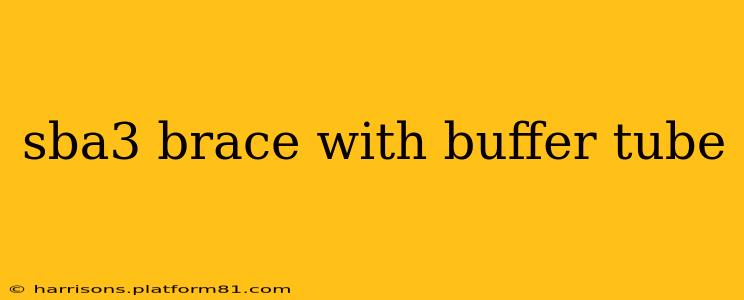The SBA3 brace, renowned for its sleek design and functionality, has become a popular choice among firearm enthusiasts. This guide delves deep into the SBA3 brace system, particularly focusing on its integration with buffer tubes. We'll explore its features, benefits, and answer common questions to provide a comprehensive understanding.
What is an SBA3 Brace?
The SBA3 is a stabilizing brace designed to improve firearm stability and control, particularly for pistol-caliber carbines (PCCs) and short-barreled rifles (SBRs). Unlike a traditional stock, it's legally classified as a brace, circumventing certain regulations. Its key feature lies in its adaptability and adjustability, allowing for a customized fit and shooting position. This adaptability is heavily influenced by the buffer tube it attaches to.
How Does the SBA3 Brace Attach to a Buffer Tube?
The SBA3 brace utilizes a standard AR-15 buffer tube for attachment. This means it's compatible with most AR-15-style lower receivers. The brace itself features a robust mounting system that securely attaches to the buffer tube's castle nut, ensuring a stable and reliable connection. This straightforward attachment method allows for easy installation and removal.
What are the Benefits of Using an SBA3 Brace with a Buffer Tube?
The combination of an SBA3 brace and a buffer tube offers several advantages:
- Improved Stability: The brace provides a more stable shooting platform compared to firing a pistol-caliber carbine without any brace or stock. This leads to improved accuracy and control, especially during rapid fire or longer engagements.
- Enhanced Shootability: The adjustable nature of the SBA3 allows for personalized fitting, optimizing the brace's position for individual comfort and shooting preferences. This enhances overall shootability and reduces fatigue during extended use.
- Legal Compliance: Using the SBA3 as a brace, as opposed to a stock, can help maintain legal compliance in jurisdictions with specific regulations on firearm stocks and overall lengths. Always check your local and state laws before purchasing or modifying any firearm.
- Versatility: The standard AR-15 buffer tube compatibility means the SBA3 can be used with a wide range of AR-15-style lower receivers and pistol-caliber carbines.
What Types of Buffer Tubes are Compatible with SBA3 Braces?
The SBA3 brace is designed to work with standard AR-15 carbine buffer tubes. These are typically 6-position collapsible tubes. While other buffer tube lengths might physically attach, they may not offer optimal functionality or comfort. Using a non-standard buffer tube could affect the brace's adjustability and overall performance.
Can I Use an SBA3 Brace with a Pistol Stabilizing Brace?
No, an SBA3 brace is not designed to be used with another stabilizing brace. It is a stabilizing brace itself, and adding another would create an unnecessary and potentially unstable configuration. Using multiple braces is likely not only ineffective but may also void any warranties associated with the SBA3.
What is the Difference Between an SBA3 Brace and a Stock?
The key difference lies in the legal classification and intended use. While both provide support for the firearm, a stock is intended for shouldering the weapon, and the SBA3 brace is designed to be held against the user’s arm or shoulder. This distinction is crucial for legal compliance. Misclassifying a brace as a stock can result in serious legal ramifications.
How Do I Install an SBA3 Brace on a Buffer Tube?
Installing an SBA3 brace is generally straightforward but requires some mechanical aptitude. Many online resources provide detailed, step-by-step instructions with visual guides. Always refer to the manufacturer's instructions provided with your specific SBA3 brace and buffer tube. Improper installation could compromise safety and stability.
Conclusion
The SBA3 brace, when paired with a compatible buffer tube, provides a significant upgrade to the shootability and stability of pistol-caliber carbines and short-barreled rifles. Its adaptability, ease of installation, and legal considerations make it a popular choice for many shooters. Remember to always prioritize safety and consult local laws before modifying or using any firearm components.
